Vegetation Areas
Overview
These guidelines are periods of time between fires (in years) bounded by 'thresholds'. Thresholds refer to the upper and lower limitations to survival for species that are particularly sensitive to very short or very long intervals between fires.
Office of Environment and Heritage (OEH) has developed fire frequency guidelines for broad vegetation types around NSW. These guidelines are periods of time between fires (in years) bounded by 'thresholds'. Thresholds refer to the upper and lower limitations to survival for species that are particularly sensitive to very short or very long intervals between fires. The fire frequency guidelines aim to ensure fire intervals are long enough to let vulnerable plants that regenerate from seed post-fire to grow to a reproductive age, while also ensuring fire happens often enough to keep short lived species around.
The recommended fire frequency intervals are based on what scientists currently know about fire ecology, and will continue to be refined as more information comes to hand. Upper thresholds in particular are currently based on very limited available data and field knowledge of life histories and regeneration requirements.
The vegetation types are classified according to a state-wide assessment, "Ocean Shores to Desert Dunes", developed in 2004 by Dr David Keith. These vegetation types are recognised by specific combinations of plants, in some cases these include plant species found nowhere else. The vegetation types are also based on factors such as the height and spacing of the dominant plants as well as geographic and landscape factors including rainfall, aspect and soil type.
Vegetation Types
Alpine complex
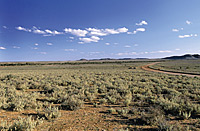
Australia's alpine complex encompasses heathlands, herbfields, freshwater bogs and alpine fjaeldmarks. Small-leaved shrubs, herbs and tussock grasses dominate the vegetation, while altitudinal climatic conditions inhibit tree growth. Site conditions, such as exposure, duration of snow cover and degree of waterlogging, determine formation of vegetation communities.
Arid Shrublands acacia subformation
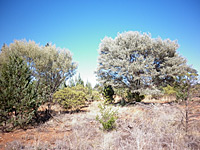
Mulga (Acacia aneura) dominated shrublands are common across far western NSW, particularly on the rocky landscapes of the Cobar Peneplain. Mulga shrublands are part of the acacia subformation of the Arid Shrublands.
Mulga and other plants that comprise the Acacia Shrublands have the capacity to regenerate after the infrequent (30-50 years) unplanned fires that mostly occur following fuel build-up during favourable climatic conditions such as significant La Niña events.
The minimum interval for fire in mulga communities should be at least 5-6 years, and the maximum approximately 40 years, although there is a recognised lack of knowledge of the best fire regimes for this vegetation subformation.
Arid Shrublands chenopod subformation
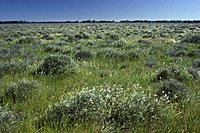
Arid Shrublands dominated by chenopods such as saltbush (Atriplex spp.), roly-poly (Sclerolaena muricata) and bluebush (Maireana spp.) are common on the far western plains. These vegetation communities are part of the chenopod subformation of Arid Shrublands.
Chenopod shrublands have low flammability, and are considered extremely fire-sensitive. Chenopod species are mostly obligate seeders with only local seed dispersal and no effective post-fire seedbank. Fire should be avoided in chenopod shrublands.
Dry Sclerophyll Forest shrub subformation
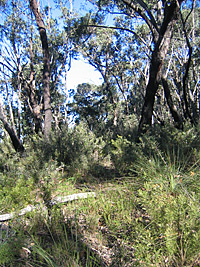
This vegetation type ranges from forests or scrub to a more open woodland structure dominated by eucalypts (but rarely 'box eucalypts'). It may also support White Cypress Pine (Callitris glaucophylla), Bulloak (Allocasuarina luehmannii) and Belah (Casuarina cristata). The shrubby understorey of these forests contain a diversity of plants that reproduce from seed after fire as well as shrubs that resprout after fire; their flowers colour the bush in spring. The cover of grasses and sedges is sparse. Dry sclerophyll forests grow on infertile, well drained soils on the coast, tablelands and the western slopes where average annual rainfall exceeds 500mm.
Variable fire intervals from 7 to 30 years are recommended to maintain diversity in this vegetation type.
Dry Sclerophyll Forest shrub/grass subformation

Dry sclerophyll shrub/grass forest consists of eucalypt forest or sometimes woodland with a sparse hard leaved shrub layer and a mainly grassy ground cover. Sometimes occurs as a transition between the shrubby subformation and grassy woodlands. It is found on similar areas to the shrubby subformation but with deeper and slightly more fertile soils.
The more grassy open forests may require slightly more frequent fire with an occasional longer interval between fires. The grass component is likely to be best maintained by short intervals, while the shrub component is predicted to increase with longer intervals. Across the state, intervals in the 5 to 25 year range, with occasional intervals of up to 50 years in some areas, have been recommended for these forests.
Forested Wetland
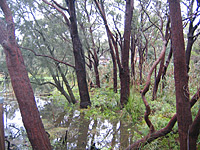
These forests typically feature hard leaved trees (paperbarks, casuarinas, eucalypts), scattered shrubs and patchy groundcover of water loving sedges and herbs. They occur on flood plains or areas of poor drainage. Scientists have not yet studied the role of fire in this vegetation type in any detail; however variable intervals between 7 and 35 years have been suggested.
Freshwater Wetland
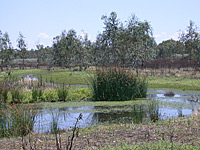
Wetlands are found along rivers and floodplains in areas that are periodically or permanently flooded with fresh water. In their natural state these wetlands usually have a dense groundcover of water loving sedges and herbs, and provide valuable habitat for waterbirds and frogs.
Drought, inland river regulation and grazing have all impacted freshwater wetlands. Wet-dry cycles play a vital role in maintaining their diversity, and ensuring these continue is the major issue for their survival. Fire intervals of between 7 to 35 years have been suggested for freshwater wetlands and variable fire regimes may play a role in the recruitment of some shrubs in drier heathy wetlands. However, for most other wetland types, fires rarely occur, if at all and have little ecological function. The use of fire therefore is not considered to be a practical management tool and should be avoided if possible. In some cases, these wetlands can occur on peat and peat fires can have a devastating effect on these valuable systems and should be avoided. Freshwater wetlands are areas of great environmental sensitivity, and need to be treated with care.
Grassland
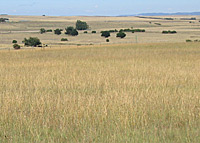
Grasslands are notable for their lack of woody plants, although scattered shrubs and trees are rarely found in these communities. A wide variety of herbs grow in the spaces between tussocks of perennial native grasses such as Kangaroo Grass (Themeda australis), common Tussock Grass (Poa labillardieri), and Wallaby Grasses (Austrodanthonia spp.). Many plants in native grasslands may not be seen by the casual observer; some may not even be visible through autumn or winter, but re-emerge to flower in spring.
Grazing and pasture improvement have extensively modified natural grasslands, so remnants where native species dominate are places to be cherished. Across the state, fires at intervals between 2 to 10 years are recommended to keep dominant grasses from overwhelming smaller herbs and to open up gaps for seedlings to germinate and grow. A slightly longer interval might be more appropriate in sites with slower growth (high altitude grasslands). As rainfall decreases, the spaces between grass clumps may also close up more slowly. Knowledge of the fire responses of grasslands is still developing.
Grassy Woodland
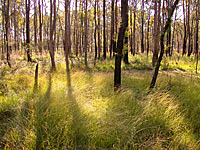
This is open eucalypt woodland or sometimes forest, mostly dominated by "box" eucalypts. The understorey is dominated by grasses with herbs and scattered shrubs. Grassy woodlands grow on flat to undulating terrain with fine textured soils of moderate to high fertility and rainfall of between 500 and 1000 mm. Most of these areas have been cleared or modified for agriculture. There is much variability within this formation across the state as it occurs from the upper coastal river valleys to the western Plains.
Across the state, a variable fire frequency of between 5 to 40 years has been recommended. In places where plants grow relatively quickly because of higher rainfall and warmer temperatures, intervals compatible with retaining a diverse, grassy understorey along with some shrubs are likely to be at the lower end of this range.
Heathland
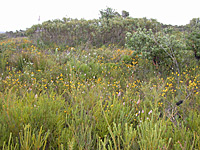
Heathland is dominated by hard leaved shrubs such as Tea-trees, Grevilleas and Banksias, many of which germinate from seed following fire. Heathland grows in higher rainfall areas on infertile soils, often in exposed positions. Fires at a range of intervals between 7 to 30 years are recommended for maintaining biodiversity in Heathlands. Within this range, variability is important as this creates the space and opportunity for large and small species with a range of responses to fire to live together.
Rainforest
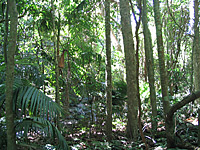
Rainforests are usually dominated by soft leaved trees with vines, ferns and palms in the understorey, and mostly grow on moist sites with fertile soils. The moist environment along with a closed canopy generally shades out the more flammable species that fuel fires, thereby reducing the incidence of fire. Invasion by weed species such as lantana and exotic grasses may increase the likelihood of fire coming into these areas during hot dry conditions.
Although a wildfire may occasionally burn through a rainforest and some rainforest plants may be able to recover from fire, rainforest is very sensitive to recurring fires; many rainforest plants are killed by fire and unable to regenerate. Fire should therefore be excluded from rainforest wherever possible.
Saline Wetland
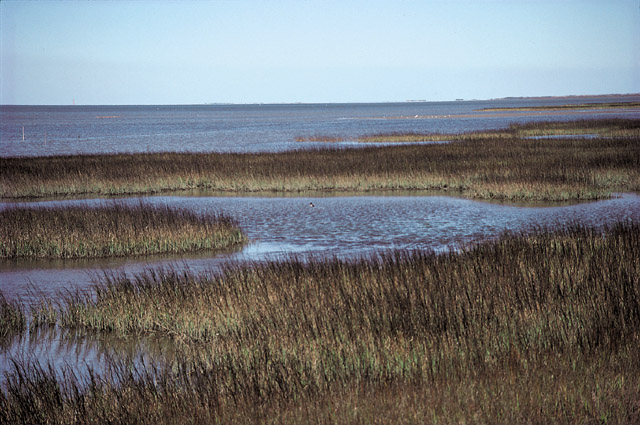
These communities include the mangroves and salt marshes that occur along the edge of coastal estuaries as well as small Inland Saline Lakes. They are not fire prone communities and fire exclusion from this vegetation is recommended.
Semi-arid Woodland grassy subformation

The woodlands of the semi-arid zone are dominated by sclerophyll trees (eucalyptus, she-oaks, wattles, cypress pines), contain drought-resistant shrubs and are home to many ephemeral (short-term or transitory) grasses and herbs.
Semi-arid Woodlands (grassy subformation) mostly occur on western floodplains and other areas with deep fine soils that are subject to occasional flooding.
Drought plays a major role in shaping the vegetation and strongly influences fire regimes. In many places fires will only burn when the grasses which flourish after good rains dry off. Fire frequency guidelines for Semi-arid Woodlands are particularly tentative due to lack of data; however intervals between 6 and 40 years have been proposed.
Semi-arid Woodland shrubby subformation
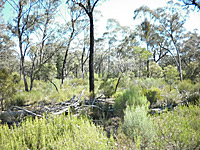
Trees in the Semi-arid Woodlands (shrubby subformation) are generally shorter in stature than those in the grassy subformation, there is less grass cover but frequently drought-resistant shrubs are dominant. Sclerophyll trees such as eucalypts, wattles, cypress pines and she-oaks dominate. Soils vary from sandy outwash soils to red-brown loams on adjacent floodplains. The sandy soils naturally favour shrubs while the heavier floodplain soils will more likely support higher grass cover.
As with other vegetation classes, disturbance affects the density of trees, shrubs and grasses within Semi-arid Woodlands. Drought plays a major role in shaping the vegetation and also influences fire regimes. In some places where the shrubby areas have thickened up considerably since European settlement, lack of fire is thought to be one of several factors involved in this change.
Fire frequency guidelines for Semi-arid Woodlands are particularly tentative due to lack of data, however intervals between 10 and 40 years have been proposed.
Wet Sclerophyll Forest (grassy sub formation)
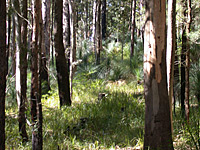
Wet sclerophyll forests are dominated by straight trunked eucalypts, with a continuous grassy understorey and sparse shrubs which may have hard or soft leaves. .These forests are mostly found on well drained, sheltered sites in the east of the state with moderately fertile soils where the average annual rainfall exceeds 900mm. It is similar to wet sclerophyll forest (shrubby subformation) but has a more open canopy, less shrubs and a more open grassy or herbaceous groundcover.
Appropriate fire frequencies for this forest type are still being debated. The present state-wide recommendation is for fires every 10 to 50 years although occasional low intensity fire on a more frequent basis may be necessary for the maintenance of understorey diversity.
Several NSW studies have found that fire frequency has a profound effect on vegetation structure in wet grassy forests. Frequently burnt areas are open and grassy, with a diverse herbaceous ground layer, while infrequent burning is associated with an increased abundance of shrubs and small trees. Each environment provides habitat for a distinct suite of plants, insects, birds and small mammals. To provide for the full range, it is important to keep some parts of the landscape open with relatively frequent fire, while other places should be burnt less often to allow a thicker understorey to develop.
Wet Sclerophyll Forest (shrubby sub formation)

The term sclerophyll refers to the hard, leathery leaves, an adaptation to drought, of many Australian trees and shrubs. Wet sclerophyll forests (shrubby subformation) are tall eucalypt forests (often exceeding 50m in height) with an understorey of ferns, herbs, and shrubs with broad soft leaves and few grasses. These forests are mostly found on sheltered sites in the east of the state with moderately fertile soils where the average annual rainfall generally exceeds 900mm.
Although it is understood that fire is important in these forests, the fire intervals needed to preserve the dominant eucalypts and safeguard other biodiversity values are still unclear. Shrubby subformation wet sclerophyll forests are likely to experience occasional intense wild fires, perhaps every 50 to 100 years. Intense fire is often needed for eucalypts to regenerate. Less intense but more frequent understorey fires may have a role in maintaining shrubs, ferns and herbs. Currently, variable fire intervals in the range 25 to 60 years are recommended for shrubby subformation wet sclerophyll forests across the state. However these recommendations may be reviewed and refined as more is learnt about fire in these forests.

